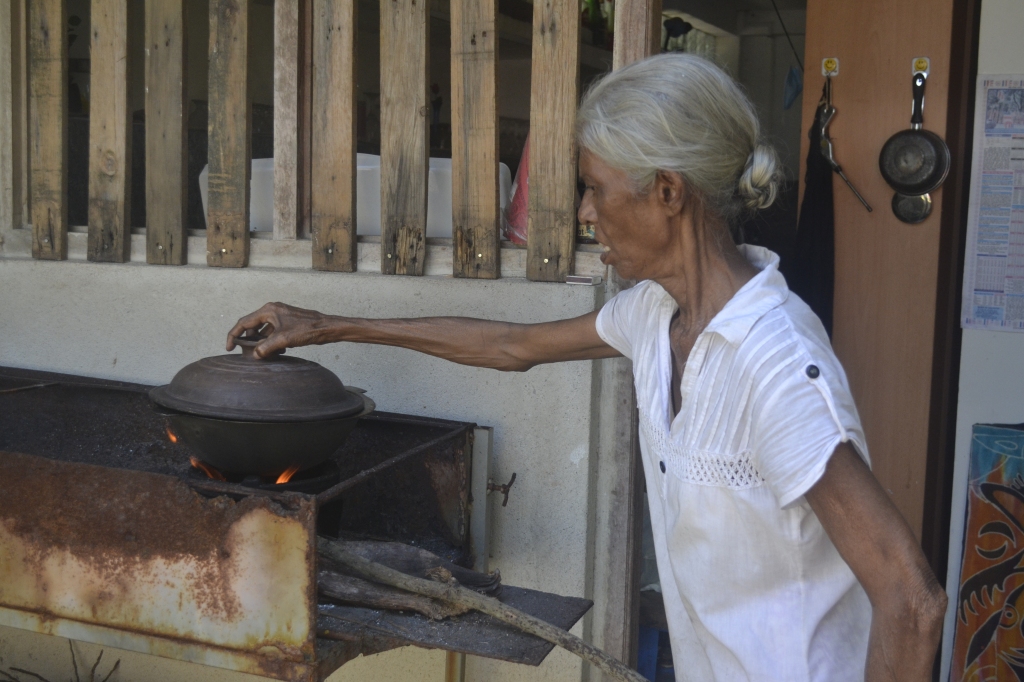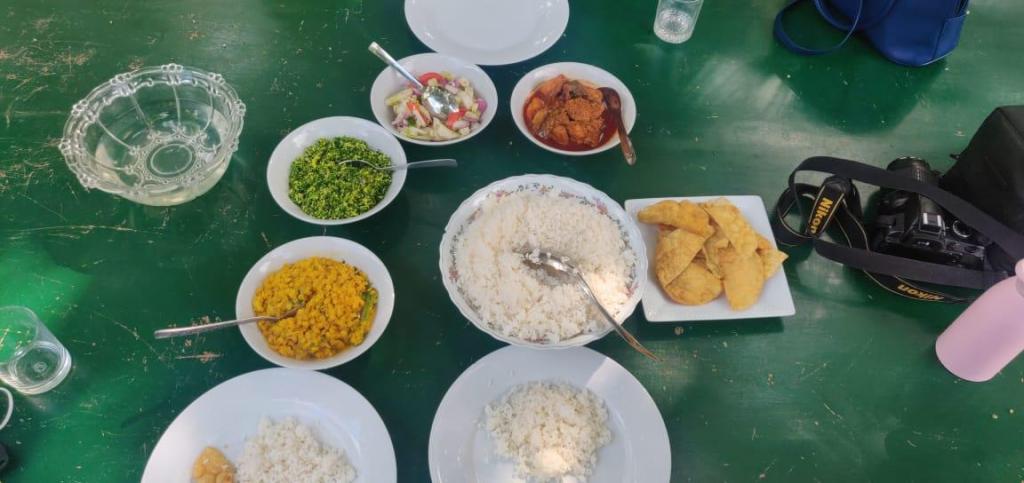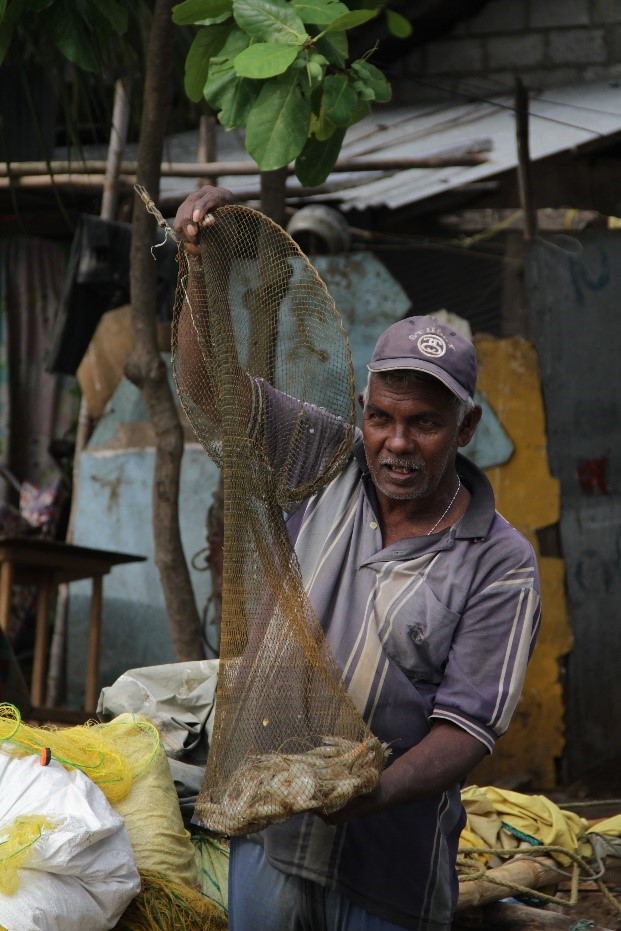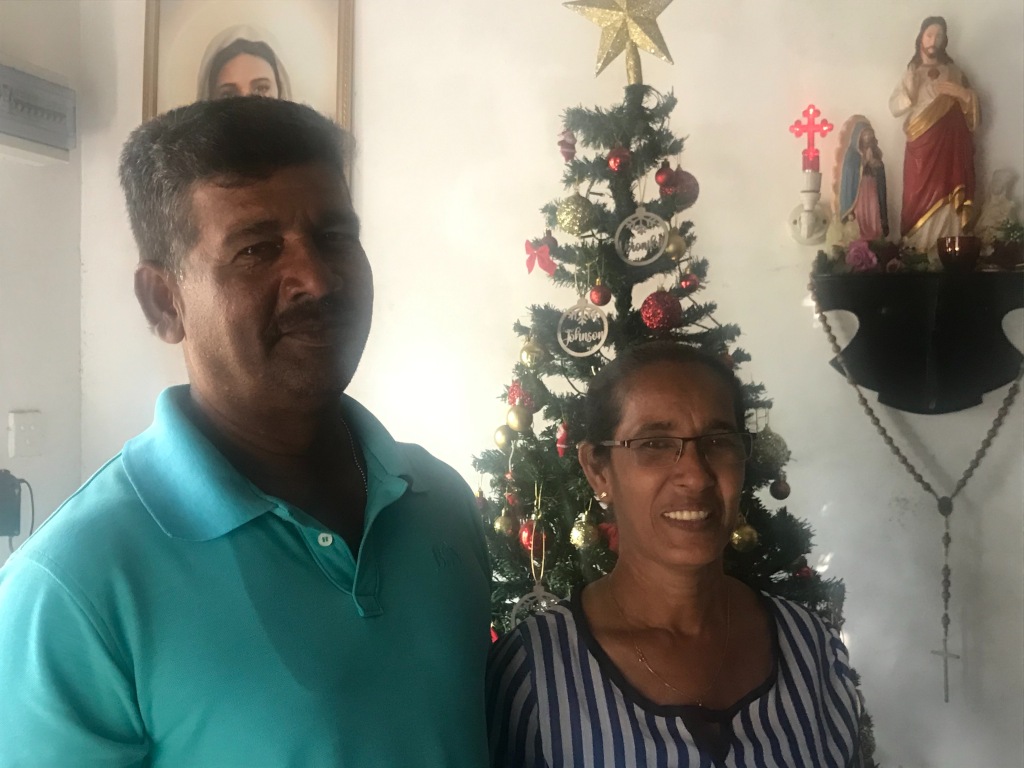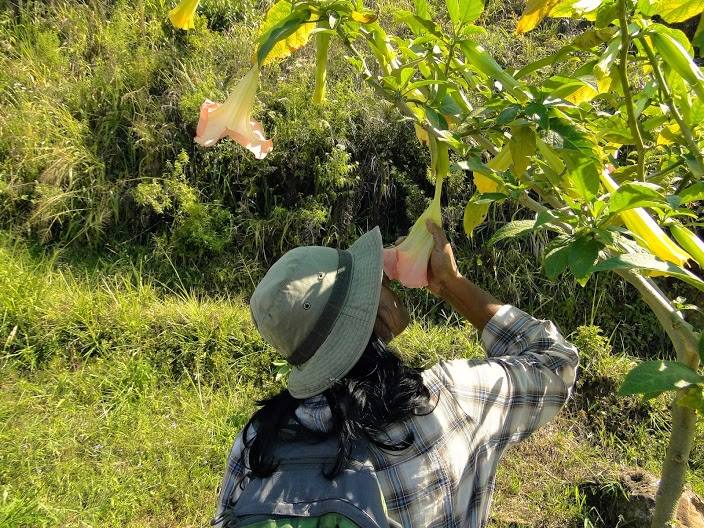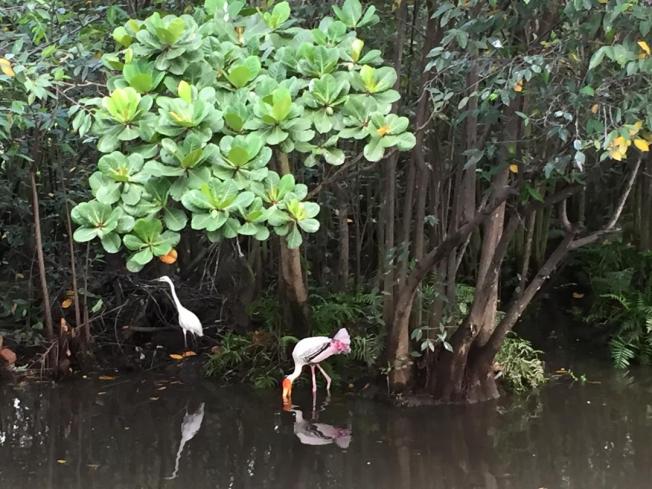The April Sinhala-Tamil New Year season usually sees the preparation of an array of traditional sweetmeats. But this was no ordinary occasion -a special order had been placed by a customer for a pooja that evening, and required everything to be done with utmost care. With an eye for cleanliness and precision, seven pieces each of seven different types of sweetmeats had to be prepared. To avoid breaking the protocol laid down by her client Latha prepared just enough to fulfill the order, meaning that any remaining mixture would go to waste.
Latha Mohendiram (55) is a mother of three – two daughters Araliya & Sewwandi and the youngest, a son who is studying ICT at a campus in Matara. “If I have a big order I will get the support from my daughters. Even my husband Susil would join if I am making Kalu Dodol“. Sweetmeat making is a family business in the Mohendiram household. Their modest two-roomed home – Latha’s ancestral home – is located close to the Piladuwa railway station… In the 1990’s, part of the house was demolished to widen the main road. Just bordering the road, Latha has built a kitchenette from which she operates her business
Making sweetmeats can be a tedious task. Many of the items she made were fried in a wok, yet a number of things have to be done before the frying. The rice and mung-bean flour that make up the base of many of the sweetmeats need to be washed the night before the preparation, and dried and ground in the morning. In years gone by, women would be hired to pound the rice. They would move rhythmically, each one bringing the heavy pole of the Mole Gaha alternatively down on the rice in the pounding Wang Gediya, carved out of a tree trunk, till the rice turned to powder. It is sieved, separating the fine powder from the coarse, and the coarse bits pounded again. These days you can get the rice pounded at the mill. Latha sends her husband to the local mill to grind larger quantities of rice. To give a special flavor to the Kavums, spices such as Cardamoms and Fennel are added to the mixture. Usually Kithul jaggery or Treacle is used to add sweetness. However Latha says that “really good Kithul jaggery is hard to find. People often add sugar when preparing the jaggery. When I can’t source the proper ingredients, I switch to brown sugar” she added.
Kithul jaggery is made from the sap harvested from the Kithul or Fishtail Palm. Tappers climb the 40-foot Kithul trees to tap its flower and obtain the liquid yield, from which the jaggery or treacle is made. Although Kithul palms grow abundantly all over the country, the clearing of rainforest buffer zones and the reduction of the home gardens – among other reasons – has led to the recent scarcity of the palm. “The future of this much-loved sweetener is uncertain” says Latha.
The story of Sinhala Kavun oil cakes dates back to 5th century or possibly earlier. The ministers of the King’s court would bring a box of Sinhala Kavum as a gift. The Dhathuwansaya noted that there were 18 kinds of kavums;Sedhi Kavum, made by the spoon; mun loalu, made of green gram flour; Ulundu kavum, made of black gram flour); Uthupu, made using a coconut shell; and Ginipu or fire Kavum. In ancient chronicles, a European trader Cosmas, notes that Kavum had been taken to the Roman court of Emperor Claudius during the 6th century. Cosmas, who visited Lanka in 545-550 AD, mentions that gold, gems, pearls, delicious fruits, Kavum and Kalu dodol from Lanka were presented to the royal court by the country’s ambassadors. The Sinhala literary chronicle Saddharma-Ratnavaliya mentions Kavum (rice-cake), Pani Kavum (rice-cake with honey) and Kudu Kavum (rice-cake made solely of rice bran sans oil) indicating Kavum’s long-standing presence in history.
The wonderful smell of the Kavum being made was making me a little greedy. Then, I was reminded that the kind of order that Latha was fulfilling prevented us from tasting them. Latha poured a spoonful of batter into the hot frying pan, inserted an ekel in the middle, twirling it around while swirling oil on to the batter, and pressing down on the sides till the middle rose up like a knob. The knob resembles a bun at the nape of the neck that most Sri Lanka women with long hair used to wear. Latha claims the size of the konde or the knob is proof of one’s skill in making kavum. Other sweetmeats don’t require this kind of twist by the wrist – it is something that Latha can definitely be proud of and explains why she is sought-after for the preparation of traditional sweetmeats in Matara.
Having placed the seven Kavum on a banana leaf-lined winnower or kulla made of bamboo and cane, she proceeded to fry batches of mung-kavun and mung guli. The mung kavum requires equal portions of mung and rice flour and sweetener The flour is slightly roasted and set aside. The Jaggery is dissolved in a cup of hot water, Cardamon and Fennel added for flavor, and a pinch of salt to taste. The roasted flour is added in little by little, while mixing all the ingredients into a smooth dough. Half of the dour is flattened on a wooden board while the other half is made into small balls. The flattened dour is cut diagonally to give equal size pieces. Latha dipped each piece in a batter made of rice flour, a dash of turmeric and water and fried them.
The difference between Mung Kavum and Narang Kavum is that the latter uses pani pol – a preparation of grated coconutand jaggery mixed over a low fire as a base, with a smaller quantity of mung and rice flour. Once the ingredients are mixed into a dough and taken off the fire, it is made into balls and fried in the batter.
To make Athiraha– a small flat round kavumwhose name means “exceedingly delicious”, Latha called her eldest daughter. She was as dexterous as her mother. She used roasted rice flour, kithul treacle and a handful of broken rice of sun-sahal, a little sesame and Cardamoms to whisk a dough on a low heat. To get the dough off the pan, she used a bit of coconut oil. When the dough had adequately cooled on plantain leaf, she formed it into small balls. “The dough has to be cool enough to shape the kavum – not too hot, but hot and malleable enough to be shaped easily” ” explained Latha. The small discs of dough is then dipped in hot oil and fried until golden and crisp. Of 18 different types of kavum, Athiraha is considered the “Queen of Tarts”.
Having used a gas burner for the preparation of five different items, Latha moves on to a Kerosene burner to prepare the next. She says the cylinder was bought from Matara twon with the greatest difficulty -she had sent her son to stay in a queue early in the morning on the day the consignment was expected. Not knowing when the next stock of gas will be available, she thinks to switch to the cheaper option of Kerosene. Fortunately, she owns three single burners which she had bought some years back. Latha also has the option of cooking using fire-wood in case there is a fuel shortage. “In the beginning we all cooked over the fire-wood stove. Cooking takes longer on the stove but it’s tastier. Of course the cleaning is messy and this is why everyone now prefers to use gas stoves” explained Latha.
Latha is preparing the batter for Kokis by adding ground rice flour to coconut milk with a bit of turmeric, Cardamoms, Fennel and a dash of salt. Measuring ingredients is something she has acquired through experience. She uses ubiquitous items like a bowl or jug and still seems to know how much is poured out of them. “Some people add an egg but this is not necessary” says Latha. She adjusts the wick on the kerosene lamp until the flame is just right. Moving her focus back to the batter she says “the mould has to be prepared for making Kokis – if it’s the first time, the trick is to heat the copper mould until its red hot over the furnace, and you then dip it in flour and fry”. She starts making Kokis – gently dipping the hot mould three-quarter in the batter and shaking it off after a while with an ekel. She allows the Kokis to fry on both sides until golden, but before that she dexterously introduces another fresh one. With total concentration on previous and new Kokis, Latha is able to coordinate and pick a new batch of bites off the frying pan. Kokis has its roots in Europe – I found out that most Finish countries prepare rosette cookies and they are popular during Christmas in Norway, Denmark as well as Spain and Turkey. It is believed that Kokis was introduced to Sri Lanka by the Portuguese around 1500.
The final item on the list was Kalu Dodol. The origin of Dodol can be traced back to Malay traders from Indonesia. The city of Hambantota, located 88 kilometres from Matara along the Southern coast, is famous for Kalu Dodol – it is the place where Malay and Chinese traders are said to have arrived in their boats called sampans. The preparation of Dodol is tedious and time consuming. Latha says her husband and two daughter support her, cooking over a wooden stove outside.
To make Kalu Dodol, the kithul jaggary and thin coconut milk are mixed and boiled in a large pan until the mixture reduces to half the original amount. Rice flour, thick coconut milk and the rest of the ingredients – bits of cashew, plums, sago and Cardamoms – are then added. It is necessary to continuously stir the mixture while simmering, to prevent it from burning and sticking to the pan. The oil that floats to the surface of the mixture must also be repeatedly removed. Once the mixture becomes thick, it is poured into a tray, pressed, and left to cool. This labor-intensive process can take up to 3-4 hours. The firm kalu dodol is cut into pieces before serving.
Kiri dodol or Kiriya is a slightly different version of dodol that is prepared for special poojas. “Usually Kiriya is prepared by males – to ensure a clean preparation they cover their mouth and nose with a cloth” says Latha. Kiri Dodol takes less time to prepare and uses more rice flour, with less coconut milk. Kithul jaggary or sugar is dissolved with the two and brought to a boil under a low flame. Like the dodol, mixture is continuously whisked to avoid getting stuck on the pan. When the consistency is just right the hot mixture is poured into a tray, and cut into pieces once it’s cooled. A good Kiriya would turn out simultaneously soft and firm. And melt in the mouth; ingredients like sago, raisin or cashew add a bit of bite and the Cardamoms an enchanting flavor.
It took less than two hours for Latha to whip up six different items of sweetmeats. She says she has been doing this since age fifteen. “Everything I learnt, I learnt by watching other women preparing traditional sweetmeats – in fact I didn’t learn it from my mother” she adds. In the village there is no shortage of women to engage in cooking – a number of friends would appear on short notice to help Latha. She had registered her business as “Araliya Rasa Kavili” in 1983, the year her eldest daughter was born. The extra income from the business has helped her family achieve a good position in society. Each of daughters one has established her own line of work, and my son is studying technology. “It gives me great pleasure to see them doing so well in life” said Latha wiping a tear off her cheek.
For a woman of Latha’s strength and talent, making sweetmeat is not a daily chore – it is a great source of satisfaction.
This article is a part of a series that illustrates pluralism through diversity of cultures in Sri Lanka. The author wishes to thank and acknowledge support received from Internews through a fellowship grant. All rights reserved by Internews @2022.








